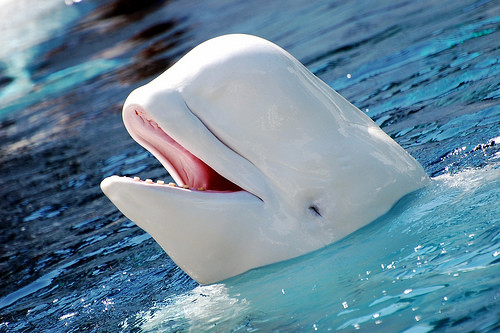How Beluga Whale Imitated Human Speech

Beluga whales are sometimes called the “canaries of the sea,” but a more apt name might be the parrots of the sea. In new research, scientists describe how one captive whale began mimicking the sounds of its human handlers.
The phenomenon isn’t unheard of – in the late 1940s, a pair of Harvard researchers published a paper in Science about how beluga calls could occasionally “suggest a crowd of children shouting in the distance.” But closer observations of belugas chatting like people were lacking, until now.
In a paper published in the journal Current Biology, researchers from the National Marine Mammal Foundation, the University of California San Diego and the U.S. Navy Marine Mammal Program describe the case of a young beluga named NOC with a penchant for making vocalizations that sounded like speech.
Lead author Sam Ridgway and others first noticed sounds coming from the whale and dolphin enclosure at the National Marine Mammal Foundation in 1984. The noises “often sounded as if two people were conversing in the distance just out of range for our understanding,” the authors wrote.
They weren’t able to trace the chattering back NOC until a later incident involving a diver. While he was working near NOC’s enclosure, the diver surfaced and asked, “Who told me to get out?” Later, the scientists realized that the repeated “out” vocalizations came from NOC.
When the scientists recorded NOC’s speech-like sounds in air and underwater, they saw that the rhythm of vocal bursts – about three per second – was similar to human speech. The frequencies of those vocalizations were also within 200 and 300 Hz, which is on par with human speech but several octaves lower than NOC’s usual sounds, according to the paper.
The researchers encouraged NOC to keep up the speech-like sounds by giving him rewards. This allowed the team to examine him more closely, to determine just how he was making the vocalizations. Using catheters inserted into NOC’s nasal cavity, they were able to find the amount of pressure changes that the whale used to create the sounds.
“Our whale mimicked human sounds by varying his nasal tract pressure and making concurrent muscular adjustments of the vibrating phonic lips while over-inflating vestibular sacs,” the authors wrote.
After NOC reached sexual maturity, he stopped mimicking human speech, but still remained quite vocal, according to the researchers.
“It seems likely that NOC’s close association with humans played a role in how often he employed his human voice, as well as in its quality,” the authors wrote.
NOC passed away in 2007, but his voice will echo on.
SOURCE: Ridgway et al. “Spontaneous human speech mimicry by a cetacean.” Current Biology 22: R860-R861, 22 October 2012.
© Copyright IBTimes 2025. All rights reserved.





















